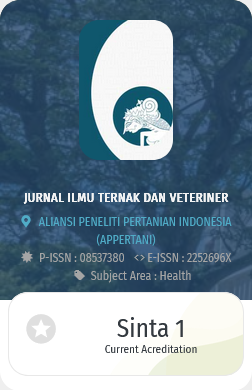Local isolate of Saccharomyces cerevisiae as biocompetitive agent of Aspergillus flavus
Abstract
Aspergillus flavus is a toxigenic fungus that contaminates feed and influences the animal health. Saccharomyces cerevisiae can be used as a biocompetitive agent to control the contamination. The ability of local isolate of S. cerevisiae as a biocompetitive agent for A. flavus was evaluated. A. flavus (30ml) was swept on Sabouraud dextrose agar (SDA), while S. cerevisiae was swept on its left and right. Plates were incubated at 28oC for nine days. Lytic activity of S. cerevisiae was detected by pouring its suspension on the centre of the cross streaks of A. flavus. Plates were incubated at 28oC for five days. Growth inhibition of A. flavus by S. cerevisiae was determined by mixing the two fungi on Potato dextrose broth and incubated at 28oC for 24 hours. Total colony of A. flavus were then observed at incubation time of 2, 4, 6 and 24 hours by pour plates method on the SDA plates and incubated on 28oC for two days. Growth of hyphae of A. flavus sweep were inhibited with the swept of S. cerevisiae. The width of A. flavus colony treated with S. cerevisiae is narrower (3,02 cm) than that of control ( 4,60 cm). The growth of A. flavus was also inhibited on the centre of cross streak where the S. cerevisiae poured. S. cerevisiae gradually reduced the colony number of A. flavus in the mixed culture of broth fungi ie. 14 x 103 CFU/ml while colony number of control is 80 x 103 CFU/ml. Results showed that S. cerevisiae could be used as biocompetitive agent of A. flavus.
Key Words: Aspergillus flavus, Saccharomyces cerevisiae, Biocompetitive agentFull Text:
PDFRefbacks
- There are currently no refbacks.

This work is licensed under a Creative Commons Attribution 4.0 International License.































